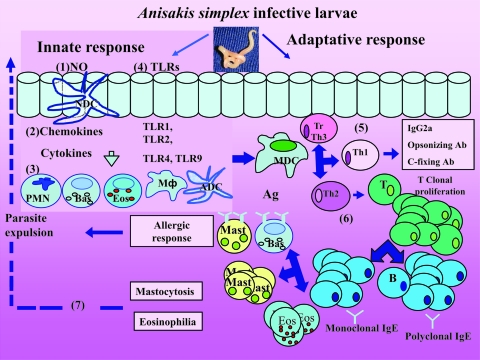FIG. 4.
Schematic representation of Anisakis simplex pathogenicity in the alimentary tract. The human patient can be exposed to A. simplex antigens from several sources: ES antigens from living larvae and somatic and cuticular antigens from dead and disintegrating larvae present in food. Epithelial cells might secrete cytotoxic molecules such as NO (1) and also chemokines and cytokines (2), which attract polymorphonuclear leukocytes (PMN), tissue macrophages (MΦ), naïve dendritic cells (NDC), basophils (Bas), and eosinophils (Eos) (3). Innate responses may also involve TLRs (4) from epithelial cells and activated dendritic cells (ADC). In the adaptive response, antigen presentation by mature dendritic cells (MDC) stimulates a double response of Th1 (5) and Th2 (6). Other T cells can be recruited as T-regulatory cells and Th3. Th1 cytokines (IFN-γ, tumor necrosis factor beta, IL-2, and IL-3) (5) induce IgG2a, opsonizing and complement-fixing antibodies, macrophage activation, antibody-dependent cell-mediated cytotoxicity, and delayed-type hypersensitivity. Th2 cytokines (IL-4, IL-5, IL-6, IL-9, IL-10, and IL-13) promote IgG1 and IgA production (6), and by T-lymphocyte (T) stimulation, antigen-specific IgE and total/polyclonal IgE are produced. Mastocytosis and eosinophilia are induced by a Th2 response and chemoattractive cytokines and may be responsible for parasite expulsion (7). Basophils are crucial for the initiation of a Th2 response. Eosinophilia may be due to the release of numerous chemotactic factors by epithelial cells, T lymphocytes, mast cells, basophils, and factors derived directly from the parasites.

